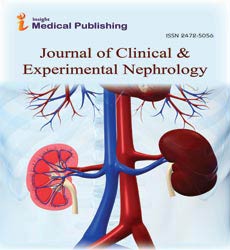Advancing Bedside Diagnostics: The Growing Role of POCUS in Nephrology
Henabell palmer
Department of Nephrology, University of Florida, Florida, USA.
Published Date: 2025-01-15DOI10.36648/2472-5056.10.1.293
Henabell palmer*
Department of Nephrology, University of Florida, Florida, USA
- *Corresponding Author:
- Henabell palmer
Department of Nephrology, University of Florida, Florida, USA
E-mail: palhe@gmail.com
Received date: December 16, 2024, Manuscript No. IPJCEN-25-20337; Editor assigned date: December 18, 2024, PreQC No. IPJCEN-25-20337(PQ); Reviewed date: January 01, 2025, QC No. IPJCEN-25-20337; Revised date: January 08, 2025, Manuscript No. IPJCEN-25-20337(R); Published date: January 15, 2025, DOI: 10.36648/2472-5056.10.1.293
Citation: Palmer H (2025) Advancing Bedside Diagnostics: The Growing Role of POCUS in Nephrology. J Clin Exp Nephrol Vol.10 No.1: 293.
Description
Point-of-Care Ultrasonography (POCUS) has emerged as a transformative tool in clinical medicine, offering real-time, bedside imaging that supports rapid clinical decision-making. While it was traditionally used in nephrology for procedural guidance-such as catheter placements-its role is now expanding significantly. Nephrologists are increasingly recognizing the value of POCUS not only in procedures but also in comprehensive hemodynamic assessments and broader diagnostic applications. This shift represents a pivotal moment in nephrology practice, as POCUS begins to bridge long-standing diagnostic gaps and improve patient outcomes.
The clinical appeal of POCUS lies in its immediacy and focus. Unlike conventional, consultative ultrasonography, POCUS allows the treating physician to both acquire and interpret images within the context of the patient’s clinical picture. This integration of imaging into routine bedside assessment enables more accurate and timely decisions, such as assessing volume status, detecting complications and guiding interventions. Especially in nephrology, where fluid management is central to patient care, the ability to rapidly assess intravascular volume, cardiac function and pulmonary congestion can be invaluable.
Historically, nephrologist-performed ultrasound was limited in scope, with most applications centered on procedural safety and basic kidney imaging. However, recent developments-such as studies on lung ultrasound in dialysis patients-have highlighted the inadequacies of physical examination alone. Lung POCUS, for example, has shown promise in guiding ultrafiltration and improving outcomes such as blood pressure control and heart failure reduction in end-stage renal disease patients. These findings reinforce the argument that POCUS should be viewed not just as a procedural tool, but as an extension of the physical examination-a "fifth pillar" alongside inspection, palpation, percussion and auscultation.
The Case for Structured Training and Competency Standards
Despite its potential, the growing use of POCUS also raises serious concerns. One of the most pressing is the risk associated with inadequate training. Unlike auscultation or palpation, ultrasound interpretation requires technical skill, anatomical knowledge and clinical judgment. Misinterpretation of images or failure to recognize limitations can result in diagnostic errors, inappropriate interventions and ultimately, patient harm. Therefore, enthusiasm for POCUS must be tempered with a clear understanding of the responsibilities that come with it.
Unfortunately, there remains a lack of standardized training and certification pathways for nephrologists interested in adopting POCUS. While interest is high-as evidenced by strong participation in workshops held by major nephrology societies-many clinicians face institutional barriers, including limited access to equipment and insufficient support from leadership. Moreover, the learning curve for POCUS is steep and proficiency cannot be achieved through brief courses alone. Longitudinal training, regular practice, expert feedback and objective assessment are all essential components of skill development.
To ensure safe and effective integration of POCUS into nephrology practice, collaboration among professional societies is critical. There is a pressing need for a unified framework that outlines clear competency milestones, offers accredited training programs and provides pathways for certification. Such a framework should not only emphasize technical skills but also focus on clinical integration-teaching nephrologists when to use POCUS, how to interpret findings in clinical context and when to seek expert consultation.
Incorporating POCUS into fellowship training programs would be an excellent starting point, ensuring that the next generation of nephrologists is equipped with these essential skills from the outset. At the same time, current practitioners should have access to continuing education opportunities that accommodate their clinical schedules. Institutions must also invest in equipment and infrastructure that allow clinicians to practice regularly and confidently.
Maximizing Clinical and Research Potential
Beyond improving day-to-day clinical care, POCUS has the potential to enrich nephrology research. Investigator proficiency in POCUS can enhance the quality of clinical studies, ensuring accurate data collection and interpretation. As the field evolves, POCUS-based metrics could become valuable endpoints in clinical trials, especially those focusing on fluid management, cardiovascular risk and dialysis outcomes.
Importantly, POCUS can also foster a more dynamic, patient-centered approach to nephrology. By bringing diagnostic capabilities to the bedside, it allows physicians to involve patients more directly in their care, improve communication and reduce delays caused by waiting for formal imaging. For patients who are acutely ill, particularly in intensive care or dialysis units, this immediacy can make a meaningful difference.
However, to fully realize these benefits, the nephrology community must embrace both the promise and the responsibility that POCUS entails. While the technology itself is accessible and increasingly user-friendly, its true value lies in the hands of a skilled clinician. Training, oversight and continued evaluation are not optional-they are essential safeguards that ensure POCUS enhances, rather than compromises, patient care.
Conclusion
POCUS is no longer a futuristic or niche skill in nephrology-it is rapidly becoming a core component of modern practice. Its integration into clinical workflows promises to improve diagnostic accuracy, procedural safety and patient engagement. But as with any powerful tool, its use must be grounded in education, standards and professional collaboration. By investing in rigorous training and committing to safe, evidence-based implementation, the nephrology community can harness POCUS to its fullest potential and lead the way in innovative, bedside care.
Open Access Journals
- Aquaculture & Veterinary Science
- Chemistry & Chemical Sciences
- Clinical Sciences
- Engineering
- General Science
- Genetics & Molecular Biology
- Health Care & Nursing
- Immunology & Microbiology
- Materials Science
- Mathematics & Physics
- Medical Sciences
- Neurology & Psychiatry
- Oncology & Cancer Science
- Pharmaceutical Sciences
